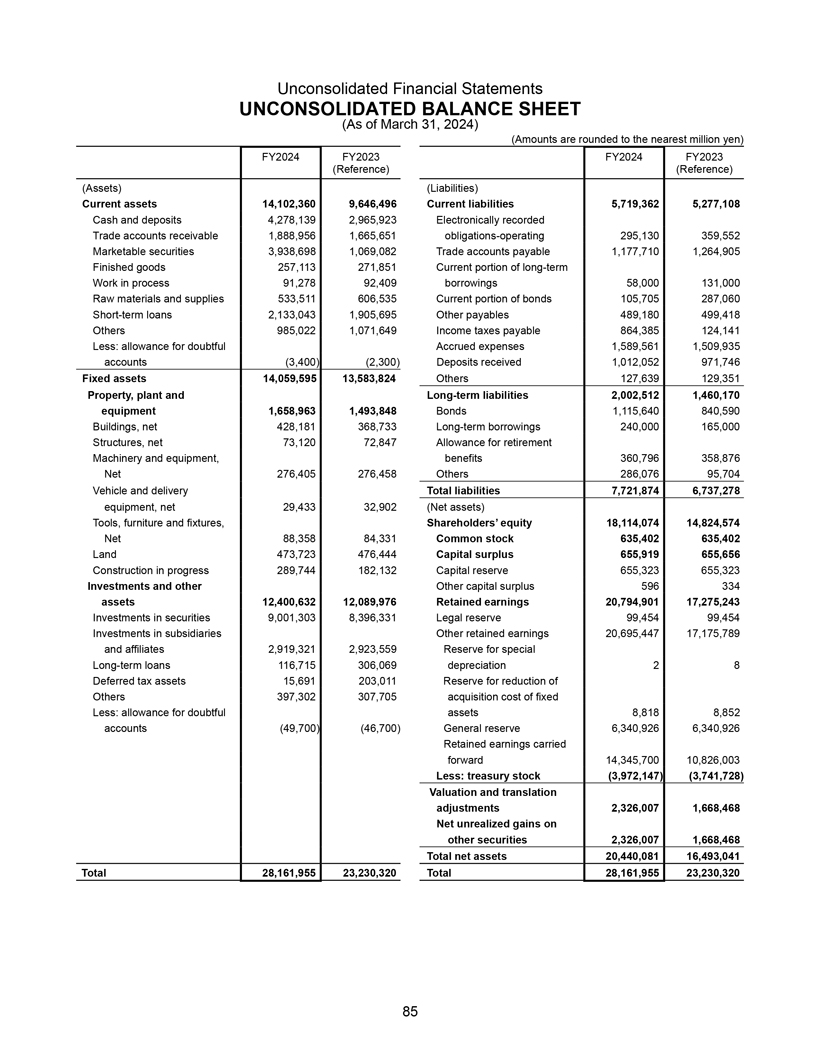
Unconsolidated Financial Statements UNCONSOLIDATED (As of March BALANCE 31, 2024) SHEET (Amounts are rounded to the nearest million yen)
FY2024 FY2023 FY2024 FY2023 (Reference) (Reference) (Assets) (Liabilities) Current assets 14,102,360 9,646,496 Current liabilities 5,719,362 5,277,108 Cash and deposits 4,278,139 2,965,923 Electronically recorded Trade accounts receivable 1,888,956
1,665,651 obligations-operating 295,130 359,552 Marketable securities 3,938,698 1,069,082 Trade accounts payable 1,177,710 1,264,905 Finished goods 257,113 271,851 Current portion of long-term Work in process 91,278 92,409 borrowings 58,000 131,000
Raw materials and supplies 533,511 606,535 Current portion of bonds 105,705 287,060 Short-term loans 2,133,043 1,905,695 Other payables 489,180 499,418 Others 985,022 1,071,649 Income taxes payable 864,385 124,141 Less: allowance for doubtful
Accrued expenses 1,589,561 1,509,935 accounts (3,400) (2,300) Deposits received 1,012,052 971,746 Fixed assets 14,059,595 13,583,824 Others 127,639 129,351 Property, plant and Long-term liabilities 2,002,512 1,460,170 equipment 1,658,963 1,493,848
Bonds 1,115,640 840,590 Buildings, net 428,181 368,733 Long-term borrowings 240,000 165,000 Structures, net 73,120 72,847 Allowance for retirement Machinery and equipment, benefits 360,796 358,876 Net 276,405 276,458 Others 286,076 95,704 Vehicle
and delivery Total liabilities 7,721,874 6,737,278 equipment, net 29,433 32,902 (Net assets) Tools, furniture and fixtures, Shareholders’ equity 18,114,074 14,824,574 Net 88,358 84,331 Common stock 635,402 635,402 Land 473,723 476,444 Capital
surplus 655,919 655,656 Construction in progress 289,744 182,132 Capital reserve 655,323 655,323 Investments and other Other capital surplus 596 334 assets 12,400,632 12,089,976 Retained earnings 20,794,901 17,275,243 Investments in securities
9,001,303 8,396,331 Legal reserve 99,454 99,454 Investments in subsidiaries Other retained earnings 20,695,447 17,175,789 and affiliates 2,919,321 2,923,559 Reserve for special Long-term loans 116,715 306,069 depreciation 2 8 Deferred tax assets
15,691 203,011 Reserve for reduction of Others 397,302 307,705 acquisition cost of fixed Less: allowance for doubtful assets 8,818 8,852 accounts (49,700) (46,700) General reserve 6,340,926 6,340,926 Retained earnings carried forward 14,345,700
10,826,003 Less: treasury stock (3,972,147) (3,741,728) Valuation and translation adjustments 2,326,007 1,668,468 Net unrealized gains on other securities 2,326,007 1,668,468 Total net assets 20,440,081 16,493,041 Total 28,161,955 23,230,320 Total
28,161,955 23,230,320 85